Electric Vans / Electric Van Reviews / Ford E-Transit Custom First Impressions
Quite possibly the most eagerly anticipated electric van? Tim Cattlin was invited to the first media driving event in Germany and got behind the wheel of Ford’s entry into the medium electric van sector.
If I’m honest, Ford has gained a bit of a reputation for being a little slow off the mark in launching new electric vans compared to most, if not all of the competition. Perhaps the company likes to take its time in developing new models, even learning from any mistakes made by others. Or, maybe it waits for battery or motor technology to mature, or even for the market to gain momentum. Certainly, when the E-Transit was launched it blew the competition out of the water in many aspects, although sales are still only forming less than 2% of the company’s UK van registrations.
The E-Transit Custom is a massive launch for Ford. The Custom is the UK’s best-selling van and operators which have been tempted to move over to a BEV (Battery Electric Vehicle) but that have wanted to remain loyal to Ford have had to be patient. Ford must be hoping that there is a pent-up demand for this, its long-awaited, fully electric medium van.
Some manufacturers are fairly restrictive in terms of the breadth of coverage that their electric models offer. Not so with Ford which offers the E-Transit Custom in a comparable number of derivatives to the diesel-powered range. The panel van is available in L1 and L2 lengths, and there’s the popular Double-cab-in-van version with its second row of seats and bulkhead. The Kombi allows full flexibility between cargo and up to 8 passenger seats, and the Multicab provides further permutations of seating and cargo. There’s also the passenger carrying Tourneo.
There are four trim levels, each providing an increasing level of specification, and at the top of the range, there’s the MS-RT van with its spoilers, skirts, diffuser and 19” alloy wheels.
There’s a single battery pack option, a 64kWh pack located under the floor and well out of harm’s way. The rear-mounted electric motor is offered at an output of 100kW or 160kW, equivalent to 135PS or 217PS, although the MS-RT model has an uprated 210kW unit, providing a huge 285PS to the driver.
That all-important range between charges? A respectable (but not class-leading) 209 miles using the WLTP test cycle, and the battery pack can be recharged in around 6.7 hours from an 11kW home charger, or a 10 to 80% top-up from a 125kW DC charger will take around 39 minutes.
Ford has said that new vapour-injected heat pump technology being introduced with E-Transit Custom for the first time in an electric vehicle improves energy efficiency, optimising the driving range. In addition, a customer can specify the van with a 2.3kW Pro Power Onboard system using the vehicle’s battery pack to power tools but with a negligible effect on range.
E-Transit Custom has, depending on the model a maximum payload of up to 1011kg, together with a class-leading towing capacity of 2300kg. Internal dimensions will mirror those of the diesel-powered van.
The E-Transit Custom looks smart. And I mean, really smart. From the front, it grabs your attention immediately with a chrome and black honeycomb grille which is simply stunning, making it instantly identifiable from the diesel version. The wrap-around front bumper includes a flap to access the charge point. Depending on the model specified there are some outstanding alloy wheel designs including diamond cut options which you’ll need to keep well clear of those vicious high kerbs to avoid expensive repairs.
Shared with the other all-new Transit Custom vans, the cab environment raises the bar to a new level which other manufacturers will no doubt aim to match. The dash is dominated by the 13” landscape touchscreen which is subtly but importantly angled towards the driver, there’s the excellent flat floor (you don’t realise how good this feature is until you’ve experienced it), the Mobile Office option pack with the tilting steering wheel, and the rooftop mounted passenger airbag which allows for a new dashboard storage area large enough to take a laptop or A4 file.
There’s inbuilt connectivity with an integrated 5G modem allowing for remote connection to telematics software, and the van even has ‘Alexa’ functionality included.
You get the impression that a huge amount of thought and consideration has gone into the design of the cab of the E-Transit Custom, with the end user in mind. How the features will improve efficiency, making the working day easier.
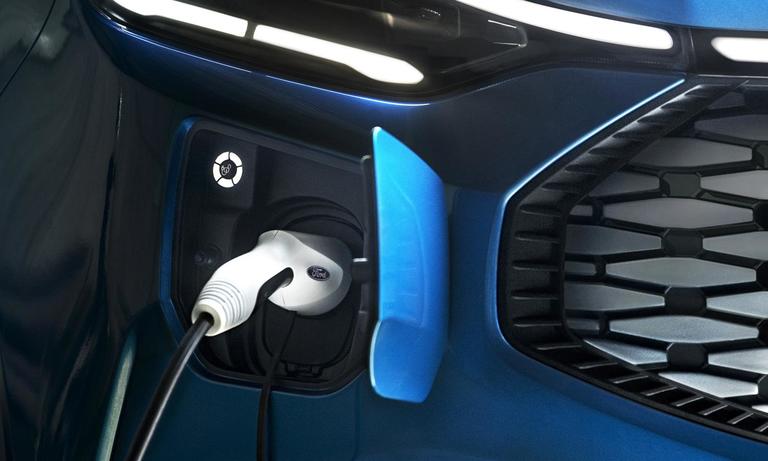
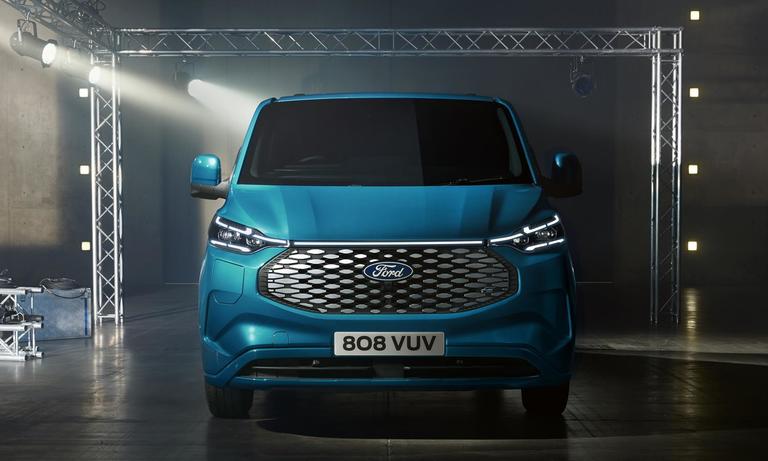
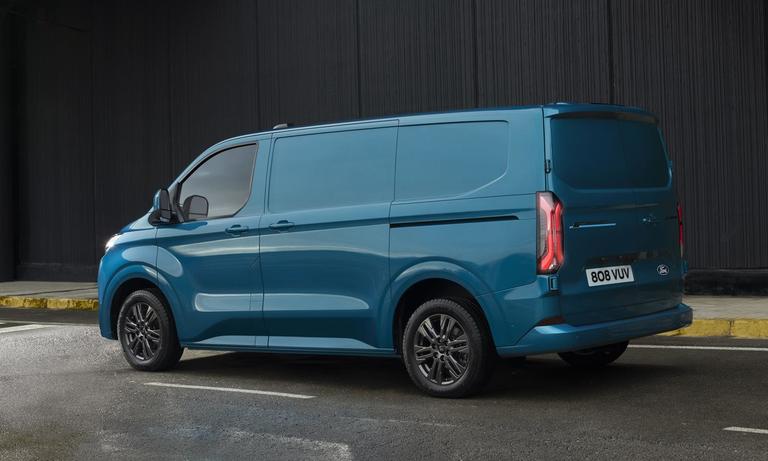

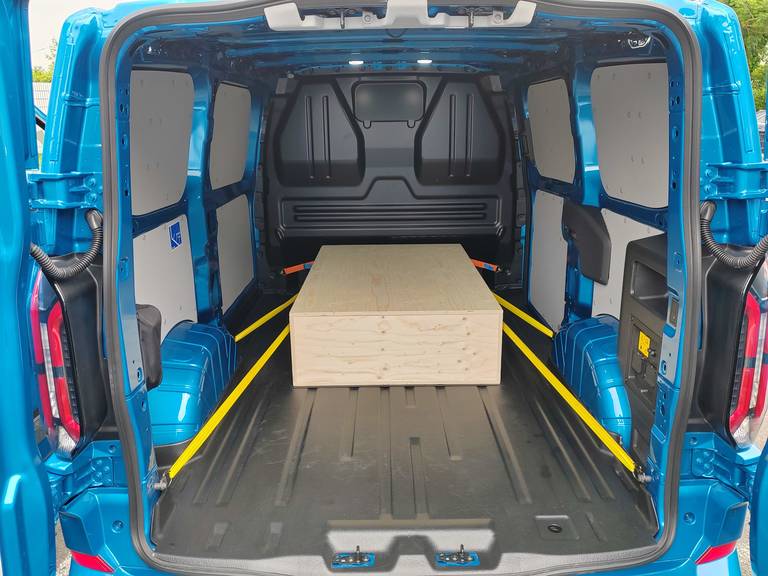
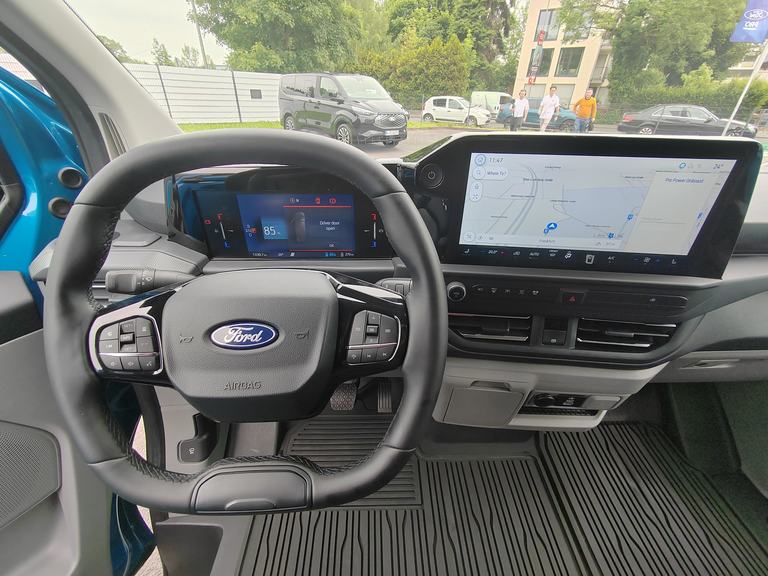
Myself and a number of other UK and Irish journalists were assembled at the front of our hotel at 08:00 in the morning and were presented with around 12 fully charged ‘Digital Aqua Blue’ E-Transit Custom vans, all ready to go with a route pre-loaded into the excellent SYNC 4 satellite navigation system. The route we had to follow was around 54km, taking us to the event centre itself. ‘My’ van was an L1H1 panel van, in Limited trim and fitted with the 100kW motor, the lowest powered in the range. Ford states that the van in this configuration has a payload of 970kgs. Standard spec includes auto air conditioning, a parking pack with a rearview camera and loads of driver aids, and the loadspace has super bright LED lighting (hooray!). Options fitted to this van included a digital rearview mirror, the mobile office pack, a driver assistance pack including nav, and a powered side load door.
Once I’d located the power button (yes, I had to elicit someone’s help, who, in my defence also couldn’t find it and had to summon a colleague) I turned the drive selector to D and gently pulled out of the hotel car park to follow the (very clear) prompts from the sat nav. I’m very familiar with driving electric vans now but the eerie silence takes some getting used to. This is a double-edged sword for manufacturers who had previously been able to rely on the noise generated by a diesel engine to mask some other unpleasant sounds. The E-Transit Custom just doesn’t make any significant noise. There’s no sound from the transmission, no intrusion from wind, no harshness or vibration, nothing except a little road noise at speed.
The route took me on a good mix of roads circumnavigating the city of Frankfurt. Fast, open motorways (or should that be Autobahns?) single carriageway country roads, but also through a number of small towns. Try as I might, I could not fault the way the E-Transit drove, it doing everything with perfection. The driving position was just right for me allowing for excellent visibility (incidentally the optional electronic rear-view mirror was a novelty and would no doubt be appreciated by novice van drivers in particular). The steering felt just right, light but retaining positivity. Performance from the 100kW motor isn’t earth shattering but, with all that 415Nm of torque being available instantly, there were absolutely no issues whatsoever in quickly pulling out into a live lane of traffic. Ride quality was excellent, the van having a pallet strapped to the inside of the loadspace with a significant (but I was unable to find out how much) amount of weight on it.
Arriving at the event centre itself, there were a number of other models on display including double cabs, Tourneos and, in a vivid lime green colour, some examples of the MS-RT version. It seemed a little rude not to take one of these out for half an hour, purely for research purposes of course. Moving from a 135PS van to one with 285PS was, shall we say ‘noticeable’ and when asked my opinion by a member of the Ford team on my return, I think I uttered the words ‘it’s just bonkers’… In all seriousness, the van is an absolute head turner and if someone wants an electric van with the ultimate performance and looks, they won’t be disappointed.
I’d like to think so. The van is virtually perfect in every way (although perhaps a range nearer to 300 miles would win it more friends) and it’s almost impossible to fault. The wider issue is getting SME’s in particular to realise that many of their preconceptions of how an electric van might not work for them are, in the real world, not such an issue after all. An electric van still isn’t right for everyone, but when the UK’s best-selling van is blessed with an excellent electric drivetrain, there’s a great possibility that some will be persuaded to make the leap.